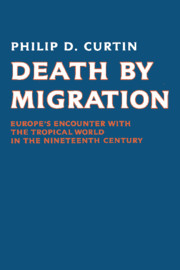Book contents
- Frontmatter
- Contents
- List of Tables, Figures, and Maps
- Preface
- List of Abbreviations
- 1 The Mortality Revolution and the Tropical World: Relocation Costs in the Early Nineteenth Century
- 2 Sanitation and Tropical Hygiene at Midcentury
- 3 Killing Diseases of the Tropical World
- 4 Relocation Costs in the Late Nineteenth Century
- 5 The Revolution in Hygiene and Tropical Medicine
- 6 The Pursuit of Disease, 1870–1914
- Conclusion
- Appendix Statistical Tables
- Bibliography
- Index
2 - Sanitation and Tropical Hygiene at Midcentury
Published online by Cambridge University Press: 29 March 2010
- Frontmatter
- Contents
- List of Tables, Figures, and Maps
- Preface
- List of Abbreviations
- 1 The Mortality Revolution and the Tropical World: Relocation Costs in the Early Nineteenth Century
- 2 Sanitation and Tropical Hygiene at Midcentury
- 3 Killing Diseases of the Tropical World
- 4 Relocation Costs in the Late Nineteenth Century
- 5 The Revolution in Hygiene and Tropical Medicine
- 6 The Pursuit of Disease, 1870–1914
- Conclusion
- Appendix Statistical Tables
- Bibliography
- Index
Summary
Most historians now believe that a mortality revolution took place between the middle of the eighteenth century and the early twentieth, but they disagree about its probable causes. One early view was that often unspecified “advances of medical science” deserved most credit, such as inoculation against smallpox introduced in the first half of the eighteenth century and vastly improved Jennerian vaccination in the nineteenth. That view may still be correct, but the “advances of medical science” have yet to be specified.
One idea that has gained favor in recent decades is that clinical medicine, which saved the lives of those already attacked by disease, played only a small part in the mortality revolution before the 1890s, at the earliest. Yet the drop in mortality was unquestionable. An alternative theory that appeared in the 1950s was Thomas McKeown's suggestion that medical advances, including smallpox inoculation, could not in themselves account for such steeply falling death rates. After eliminating other potential causes, McKeown concluded that only nutrition had the probable power to produce such an important result.
The problem with this argument is that it is based on a series of negatives followed by a guess. Thus, if A, B, C, D, and so on did not bring about the observed effect, the cause must have been X – X being nutrition. No one doubts the important relationship between nutrition and health, but whether it was the fundamental cause of the mortality revolution is impossible to demonstrate empirically.
- Type
- Chapter
- Information
- Death by MigrationEurope's Encounter with the Tropical World in the Nineteenth Century, pp. 40 - 61Publisher: Cambridge University PressPrint publication year: 1989



